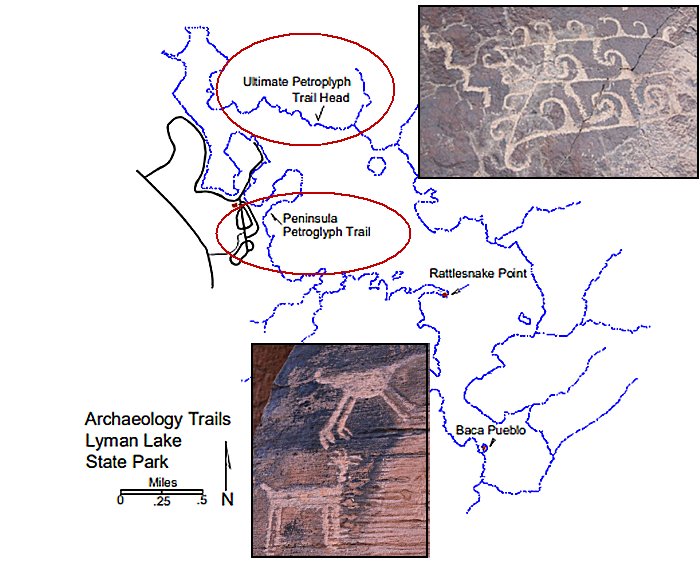Lyman Lake Petroglyphs And Famous Kokopelli-Flute Player Left By Ancestors Of The Hopi Indians
A. Sutherland - AncientPages.com - Lyman Lake petroglyphs can be found in Lyman Lake State Park, Arizona. Ancient rock art images are etched into boulders; they are numerous signs and symbols were left by ancients passing the area.
Most of the Lyman Lake rock art was created by pecking and no pictographs (paintings on rock) were found in the area. There are depictions of specific animals, masked figures, and a wide variety of geometric shapes.
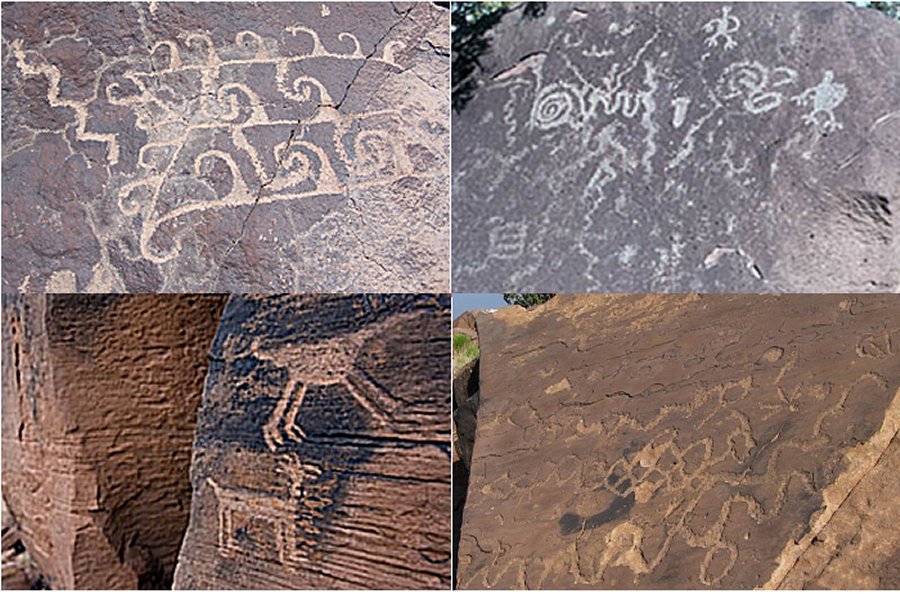
Hopi people interpret many of the petroglyphs in the Park as records of the migrations of their ancestors through this area. In many cases, the designs are associated with particular clans and events that took place during their migrations; others are clan symbols. Credits: Azcentral.com/Arizona State Parks
Archaeologists believe that the diversity of petroglyph styles indicates that more than one prehistoric culture made this rock art, but there is also a possibility that the style used by one culture changed through time.
The earliest petroglyphs in the Park are most probably dated from the Archaic (6000 BC to AD 300) and Basketmaker (from about AD 300 to 700) periods. Most of the petroglyphs date to the Pueblo periods (AD 700 through 1400), with the majority created during the final three centuries of
prehistoric occupation. Most recently, some archaeologists have begun to see petroglyphs as products of shamanistic rituals.
At Ultimate Rock, there is a large petroglyph-covered boulder but one of the most famous rock art in the area of Lyman Lake, Arizona is Kokopelli - a flute player. There are many stories about Kokopelli and he was not only a trickster god but also a fertility god, healer, and wonderful storyteller.
The Hopi were familiar with Kokopelli and he is mentioned in their migration and emergence account. According to the Hopi legend, when their people emerged into the Fourth World (our current world) they encountered an eagle that shot an arrow into insects that carried the power of heat.
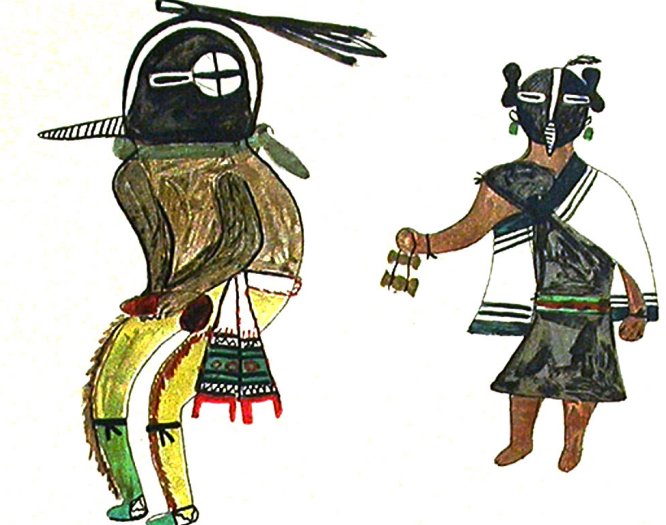
Kokopelli and Kokopelli Mana as depicted by the Hopi. Jesse Walter Fewkes, Hopi katcinas drawn by native artists, 1903 via Wikipedia
These insects known as máhus were not seriously harmed because as soon as they started to play on their flute, their bodies healed. The Hopi were accompanied by the two máhus on their migration.
One of these insects were called Kókopilau (kóko meaning “wood” and pilau meaning “hump”) because he looked like wood. He played on his flute and carried a bag of seed which he scarred across the lands. The wonderful music of his flute made the seeds grow.
The earliest petroglyphs in the Park date from the Archaic (6000 BC to 300 AD) and Basketmaker (from about 300 to 700 AD) periods. Most of the petroglyphs date to the Pueblo periods (700 through 1400 AD).
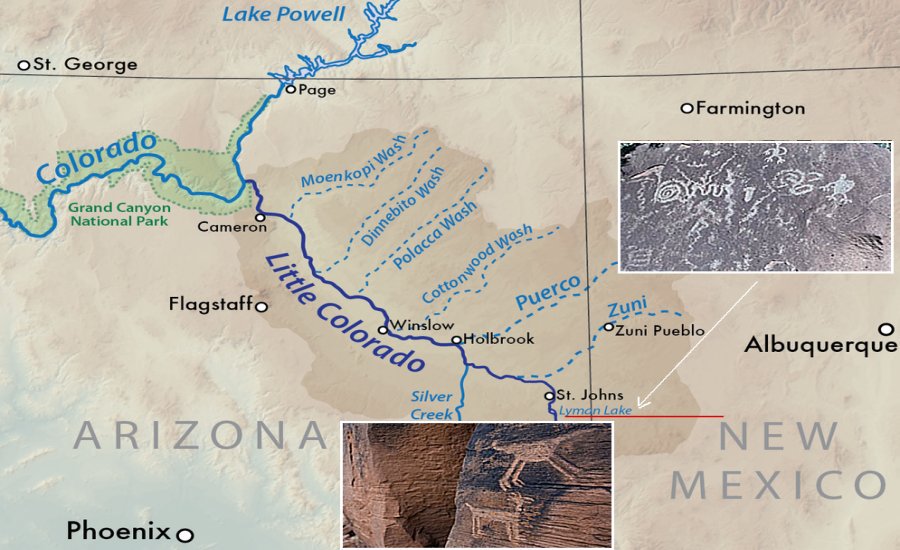
The prehistoric inhabitants of the upper Little Colorado River drainage left a rich material record of their time in the valley.
Some archaeologists associate the Lyman Lake rock art with shamanic rituals, but neither the Arizona State University's archaeologists nor the Hopi Indians agree with this theory. The ruined buildings, artifacts, and petroglyphs (“rock art”) provide the scientific evidence that permits archaeologists to understand the area’s history.
The pueblo ruins were built by ancestors of the Hopi Indians, who see the abandoned houses, broken pottery fragments, and markings on the rocks as a record left by their ancestors during the migrations described in Hopi oral tradition.
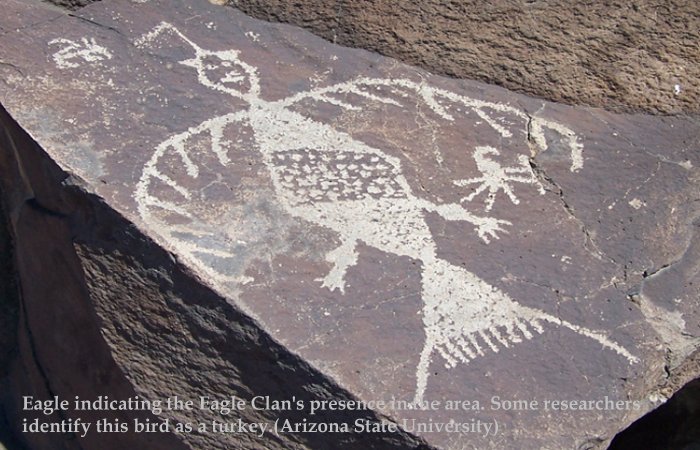
At Hopi, each clan has a narrative of its own history, from emergence, through migration, to eventual settlement on the Hopi mesas. Photo: Glyph Hunter
Created as an irrigation reservoir by damming the Little Colorado River, Lyman Lake State Park contains a number of pueblo ruins and rock art sites. Both Rattlesnake Point Pueblo and the Lyman Lake rock art site are important places for Hopi people. Hopi people consider these sites as homes of their ancestors during their migrations and the petroglyphs are these ancient people's signs.
In many cases, the designs are associated with particular clans and events that took place during their
migrations; others are clan symbols.
Written by – A. Sutherland - AncientPages.com Senior Staff Writer
Copyright © AncientPages.com All rights reserved. This material may not be published, broadcast, rewritten or redistributed in whole or part without the express written permission of AncientPages.com
Expand for referencesMore From Ancient Pages
-
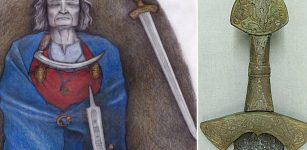 Suontaka Weapon Grave: New Light On Strong Female Leaders And Warriors Of Late Iron Age Finland
Archaeology | Jul 29, 2021
Suontaka Weapon Grave: New Light On Strong Female Leaders And Warriors Of Late Iron Age Finland
Archaeology | Jul 29, 2021 -
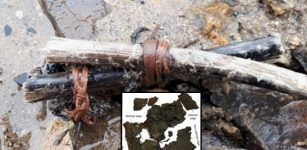 7,000-Year-Old Unique Artifacts Discovered Under Melting Ice In Canada
Archaeology | Nov 30, 2023
7,000-Year-Old Unique Artifacts Discovered Under Melting Ice In Canada
Archaeology | Nov 30, 2023 -
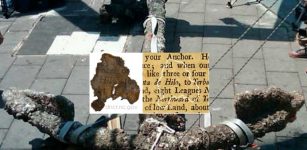 Tiny Paper Scraps From ‘Queen Anne’s Revenge’ Shed Light On Reading Habits Of Blackbeard’s Pirates
Archaeology | Jan 7, 2018
Tiny Paper Scraps From ‘Queen Anne’s Revenge’ Shed Light On Reading Habits Of Blackbeard’s Pirates
Archaeology | Jan 7, 2018 -
 Alwilda – Imprisoned Viking Princess Who Became A Pirate Queen
Featured Stories | Jun 14, 2019
Alwilda – Imprisoned Viking Princess Who Became A Pirate Queen
Featured Stories | Jun 14, 2019 -
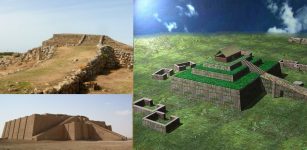 Monte d’Accoddi – Mesopotamian Ziggurat In Europe Built By King Of Uruk?
Featured Stories | Feb 5, 2018
Monte d’Accoddi – Mesopotamian Ziggurat In Europe Built By King Of Uruk?
Featured Stories | Feb 5, 2018 -
 Frightening Ancient Underground World Discovered In Tibet – Evidence Of A Lost Advanced Civilization?
Featured Stories | Feb 17, 2024
Frightening Ancient Underground World Discovered In Tibet – Evidence Of A Lost Advanced Civilization?
Featured Stories | Feb 17, 2024 -
 On This Day In History: Harvard University – America’s Oldest Learning Institution Was Founded – On Oct 28, 1636
News | Oct 28, 2016
On This Day In History: Harvard University – America’s Oldest Learning Institution Was Founded – On Oct 28, 1636
News | Oct 28, 2016 -
 Europe’s Largest Predatory Dinosaur Unearthed On The Isle Of Wight
Archaeology | Jun 11, 2022
Europe’s Largest Predatory Dinosaur Unearthed On The Isle Of Wight
Archaeology | Jun 11, 2022 -
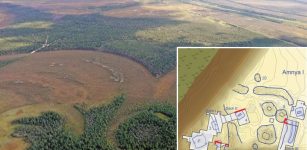 Discovery Of World’s Oldest Fortresses Reshapes Our Understanding Of Hunter–Gatherers
Archaeology | Dec 7, 2023
Discovery Of World’s Oldest Fortresses Reshapes Our Understanding Of Hunter–Gatherers
Archaeology | Dec 7, 2023 -
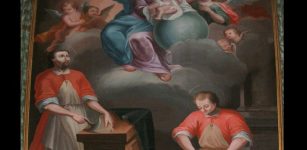 On This Day In History: Execution Of Saints Crispin And Crispinian – On Oct 25, 286
News | Oct 25, 2016
On This Day In History: Execution Of Saints Crispin And Crispinian – On Oct 25, 286
News | Oct 25, 2016 -
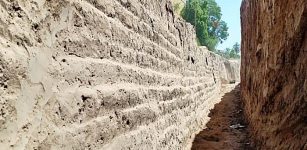 Ancient Mud-Brick Roman Ovens And Massive Wall Dated To Egyptian Late Period Unearthed In Luxor
Archaeology | Jun 26, 2020
Ancient Mud-Brick Roman Ovens And Massive Wall Dated To Egyptian Late Period Unearthed In Luxor
Archaeology | Jun 26, 2020 -
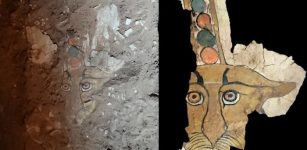 Rare Ancient Leopard Painting Discovered On Sarcophagus In Aswan, Egypt
Archaeology | Feb 25, 2020
Rare Ancient Leopard Painting Discovered On Sarcophagus In Aswan, Egypt
Archaeology | Feb 25, 2020 -
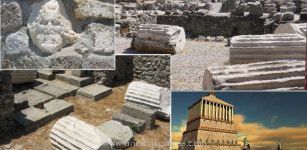 Halicarnassus’ Monumental Tomb Built With Shining Stones Belonged To Carian Ruler Mausolus
Featured Stories | Jul 20, 2016
Halicarnassus’ Monumental Tomb Built With Shining Stones Belonged To Carian Ruler Mausolus
Featured Stories | Jul 20, 2016 -
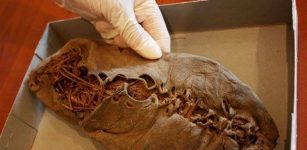 World’s Oldest Shoe Is 5,000-Year-Old
Archaeology | Jul 10, 2015
World’s Oldest Shoe Is 5,000-Year-Old
Archaeology | Jul 10, 2015 -
 4,000-Year-Old Serpent-Shaped Wooden Stick Unearthed in Southern Finland
Archaeology | Jun 30, 2021
4,000-Year-Old Serpent-Shaped Wooden Stick Unearthed in Southern Finland
Archaeology | Jun 30, 2021 -
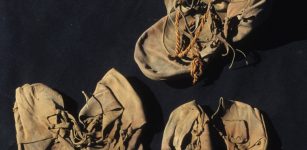 Unsolved Ancient Mystery: Why Were These Foreign Shoes Hidden In A Temple?
Archaeology | Mar 29, 2014
Unsolved Ancient Mystery: Why Were These Foreign Shoes Hidden In A Temple?
Archaeology | Mar 29, 2014 -
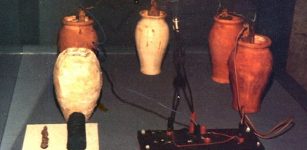 Was Prehistoric Baghdad Battery A Unique Find Of The Ancients? – Did Its Manufacturers Discover Electricity By Accident?
Ancient Technology | Mar 8, 2019
Was Prehistoric Baghdad Battery A Unique Find Of The Ancients? – Did Its Manufacturers Discover Electricity By Accident?
Ancient Technology | Mar 8, 2019 -
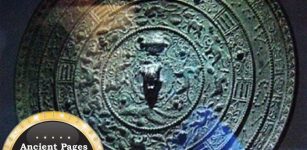 Mystery Of Ancient “Magical” Mirrors – Some Of The Strangest Objects In The World
Artifacts | Apr 21, 2011
Mystery Of Ancient “Magical” Mirrors – Some Of The Strangest Objects In The World
Artifacts | Apr 21, 2011 -
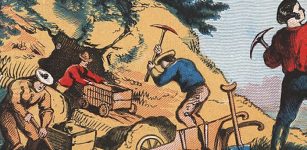 DNA Reveals Participants In California’s Gold Rush Dined On Salted Atlantic Cod
Archaeology | Jan 7, 2022
DNA Reveals Participants In California’s Gold Rush Dined On Salted Atlantic Cod
Archaeology | Jan 7, 2022 -
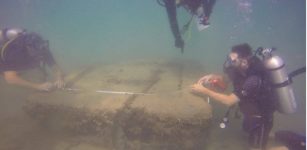 New Unique Ancient Underwater Finds In The Ports Of Caesarea And Acre
Archaeology | Aug 11, 2021
New Unique Ancient Underwater Finds In The Ports Of Caesarea And Acre
Archaeology | Aug 11, 2021

